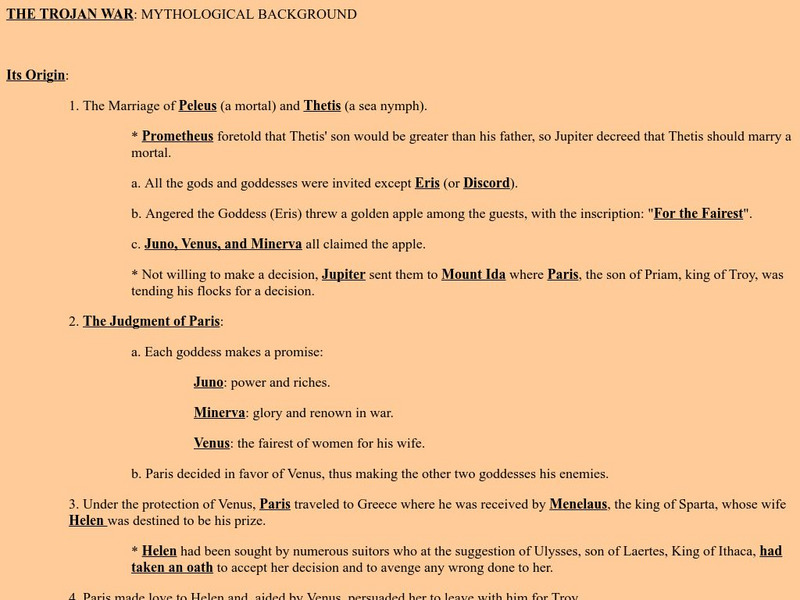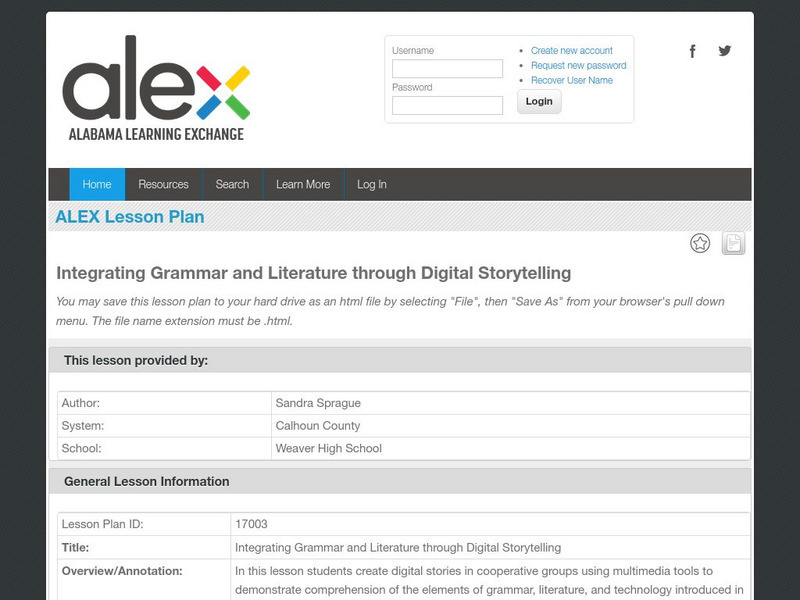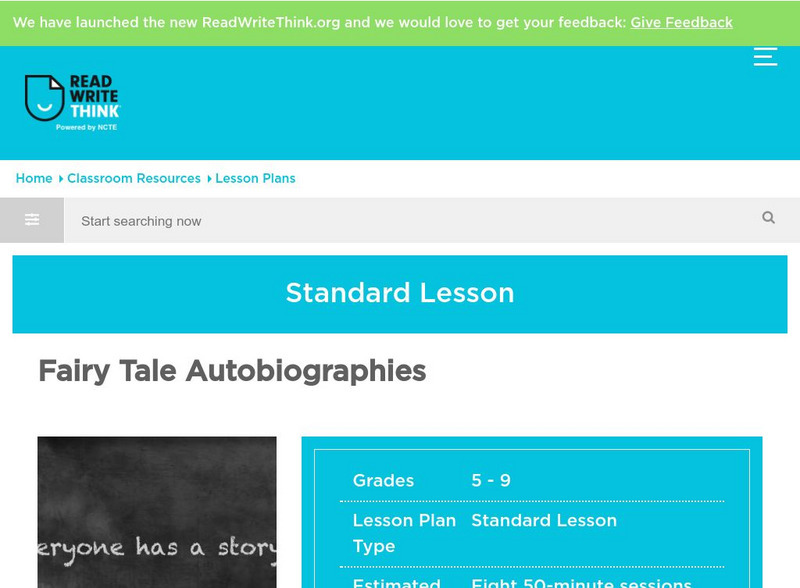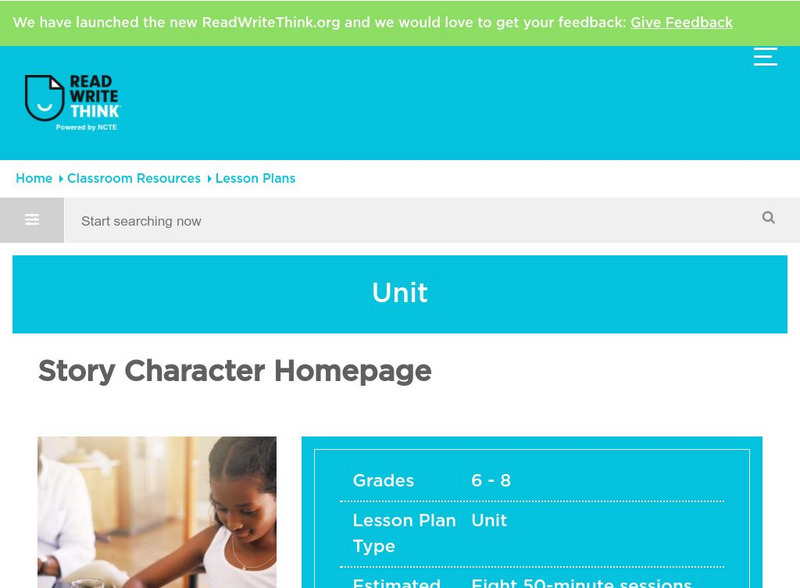Other
Mythological Background of the Trojan War
Really good outline that gives more than just the basic information about the mythological background to the Trojan War. Shows the actions of both men and gods in this legendary tale.
Other
The Augustan Period, Vergil, and the Aeneid
Explores the relationship between the Augustan period of Roman literature, its most famous poet, and his greatest work. Provides good background to the life of Vergil and the genre of epic poetry.
Alabama Learning Exchange
Alex: Grammar and Literature Through Digital Storytelling
In this lesson students create digital stories in cooperative groups using multimedia tools to demonstrate comprehension of the elements of grammar, literature, and technology introduced in the lesson. Students become actively involved...
Other
Suny: Conventions of Writing Papers About Literature
A professor's excellent explanation of how to write a professional sounding essay. Covers all aspects of an essay, and detailed examples give information on exactly how to write the essay.
ReadWriteThink
Read Write Think: Enchanting Readers With Revisionist Fairy Tales
Contains plans for four lessons that ask students to read, compare, and contrast different versions of fairy tales in order to explore age-appropriateness and formats of texts. In addition to objectives and standards, this instructional...
ReadWriteThink
Read Write Think: Fairy Tale Autobiographies
Lesson which requires students to analyze fairy tales for literary elements such as characters, setting, conflict, and theme. Students work in groups and write about, edit, and illustrate their fairy tales.
ReadWriteThink
Read Write Think: Choose Your Own Adventure: A Hypertext Writing Experience
This series of lessons involves student collaboration, writing and analytical skills, technology and imagination. While the lesson suggests use of FrontPage, it would also be possible to use a number of other authoring tools.
ReadWriteThink
Read Write Think: Story Character Homepage
Online lesson which allows for students to create an electronic "Home page," for a specific character when reading a class novel. Students research and create web pages, then present findings to the class.
Quia
Quia: Rags to Riches: Literary Elements
Show off your knowledge of literary elements by playing this game. Just answer 15 questions correctly, and be the big winner.
Other
Georgia Perimeter: Choosing and Writing for an Audience
This resource goes extensively into the importance of establishing an audience when writing. It also defines types, how to choose, and how to write for an audience.
PBS
Pbs: The American Novel: Literary Timeline: Literary Movements: Modernism
Background on the literary time period known as Modernism, including characteristics of writing at this time as well as a list of important modernist authors.
University of Victoria (Canada)
The U Vic Writer's Guide: Literary Term: Novel
This site provides a general overview of the novel, including its history and generic forms. Includes a few examples and related links.
Other
Concepts and Practices for Writing Courses: Interpreting Literature
This tutorial surveys the way readers should interpret literature or text in symbols, syntax, meaning, and the like. The article features a Literary Toolkit for Analyzing Literature.
Houghton Mifflin Harcourt
Harcourt: Biographies: Homer
Brief biography of Greek poet Homer with list of additional books to read.
Other
Today in Literature: Today's Story
Each day, this site provides a different biography or interesting story about a great book or day in literary history. Many of the archived articles are available in full; others are available only in summary for free access. Authors run...
ReadWriteThink
Read Write Think: Bright Morning
Use this lesson to delve into the exploration of character development in fiction through the novel "Bright Morning," by Scott O'Dell.
Goshen College
Goshen College: Literary Analysis Guide
This resource not only explains how to analyze a text, but also, provides student examples of literary texts. W.9-10.9b Research/Argum, RI.11-12.5 Evaluate text structure
Smithsonian Institution
Smithsonian Education: Idea Lab: Myths in Words and Pictures
Interactive website in which students learn about myth and symbols in art and storytelling. Engaging and informative with images and informational text.
TES Global
Tes: Analyzing & Comparing Non Fiction
[Free Registration/Login Required] Resource notes to aid students as they analyze different types of nonfiction. The GAP (genre, audience, and purpose) acronym is provided to use when comparing nonfiction texts.
Other
Biographical Dictionary
Students are able to connect to a search engine containing a dictionary that "covers more than 28,000 notable men and women who have shaped our world from ancient times to present day."
Caro Clarke
Loving Your Characters Too Much
This article is the fifth in a series that is designed to help new authors with their new novels. This lesson focuses on your main character and what happens when that character lacks character flaws.
Caro Clarke
Not Stopping the Reader: How to Avoid Stumbling Blocks
This is the eighth article in a series that focuses on helping the new novel author. This article looks at how the author can avoid creating stumbling blocks that disrupt the flow of the novel.
Caro Clarke
A, B, and C Characters
This is the ninth article in a series that focuses on helping the new novel author. This article focuses on what the author calls "A, B, and C Characters," used to describe the different levels of characters.
Caro Clarke
Explaining Too Much: Why More Is Less
This is the eleventh article in a series that is designed to help the new novel author. This article focuses on how to eliminate needless information in your novel. The key is to not explain too much about the action.
























